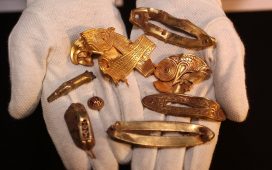If you’ve been following the Olympics action in Paris, you might have noticed that this year’s track looks rather different.
With an all-purple aesthetic, Paris has taken a break from the usual dusty red favoured by venues around the world.
However, colour isn’t the only thing different about the Stade de France track – as it could be the fastest Olympic track yet.
The track features an eco-friendly base made of ground mussels and clams and a system of air bubbles designed by computer algorithms.
Mondo, the Italian Company which built the track, even says that Paris’ course could be up to two per cent faster than the track at the Tokyo 2020 Games.

Colour isn’t the only thing different about the Stade de France track – as it could be the fastest Olympic track yet

Mondo, the company that produced the track, says it performs 2 per cent better than the Toyko 2024 track
The Paris 2024 track (left) was built by the same company who made the Tokyo 2020 track (right) and features new materials and designs
The track was built in the Stade de France, Paris’ biggest stadium, and serves as the base for all of the track events.
From the surface it might look simple, but beneath the purple exterior is a surprisingly complex construction.
It uses three different colours of surface material: a bright lavender for the course itself, darker purple for the service areas, and grey for the exterior curves at either end.
Even the glue used to bind the material to the ground is purple in case any of the outer layers should break away.
Mondo used 2,800 pots of purple glue to hold down more than 1,000 sheets of material.

Paris’s new Olympic athletics track features a bold purple colour pallet but is also hiding some technical improvements to make it the fastest track yet

The track was made from more than 1,000 rolls of purple material as well as 2,800 pots of purple glue
However, while the colour might be striking, it is not the Paris track’s biggest innovation.
The company says that this year’s track uses an improved version of the polymeric material it first developed for the 2020 Tokyo Olympic Games.
Alessandro Piceli, a research and development manager at Mondo, said: ‘We are focusing on the dynamic connection between the track and a new generation of shoes.
‘A new granule of polymeric material, made especially for it, was inserted in the Tokyo track. We have made it even better now.’
That advancement resulted in a vulcanised rubber surface which offers more traction for modern running spikes as well as for the tyres of wheelchairs used in the Paralympics.

The track’s surface (pictured) is made of a vulcanised rubber material designed to give better traction with modern running spikes

Beneath the surface, the track features a low-density structure of elliptical air pockets which give more spring to an athlete’s steps
Below the surface, the Paris track features a low-density structure filled with air bubbles which are designed to return more energy from each step.
Mondo says that it was ‘impossible’ to design these using traditional methods and instead opted to use computer algorithms to simulate the interaction between runner and track.
The company claims that the result is a track that is both softer and more efficient in returning energy to the athlete – hopefully helping them run faster without injury.
Compared to the Tokyo 2020 track, this new structure should give 2.63 per cent more ‘optimised running efficiency’ and absorb around one per cent less energy with each step.
At Tokyo 2020, three world records and 12 Olympic records were set in track and field events, including the women’s and men’s 400 metres hurdles and the women’s triple jump.
How much of that is down the track is unclear, but Mondo hopes that the Paris track should be around two per cent faster than the previous Olympics.
Already, one Olympic record and two world records have been set on the new track, including the mixed 4 × 400 metres relay and the men’s 10,000 metres.
In addition to being faster, the Paris track is also more eco-friendly than any previous venue.
The track is partially made from the shells of bivalve molluscs like mussels and clams which are ground down into a fine powder.
Since 2021, Mondo has been partnered with a mussel farming and fishing company called Nieddittas.

Two world records and one Olympic record have already been broken on the track, and with more events to come further records could still be beaten
Niedditas harvests, cleans and prepares the shells before handing them over to Mondo – diverting tonnes of waste away from landfills.
The shells are largely made of calcium carbonate, a chemical used in making running tracks which would normally be mined out of the ground.
By switching to biological sources, Mondo claims to be reducing its reliance on mining and saving the equivalent carbon emissions of driving a diesel car 60,000 km (37,300 miles).
Of course, this innovation does not come cheap and the new track is estimated to have cost between €2-3 million (£1.78-2.58 million).
However, with a number of athletics finals still to come, many athletes will surely be hoping that investment pays off.













